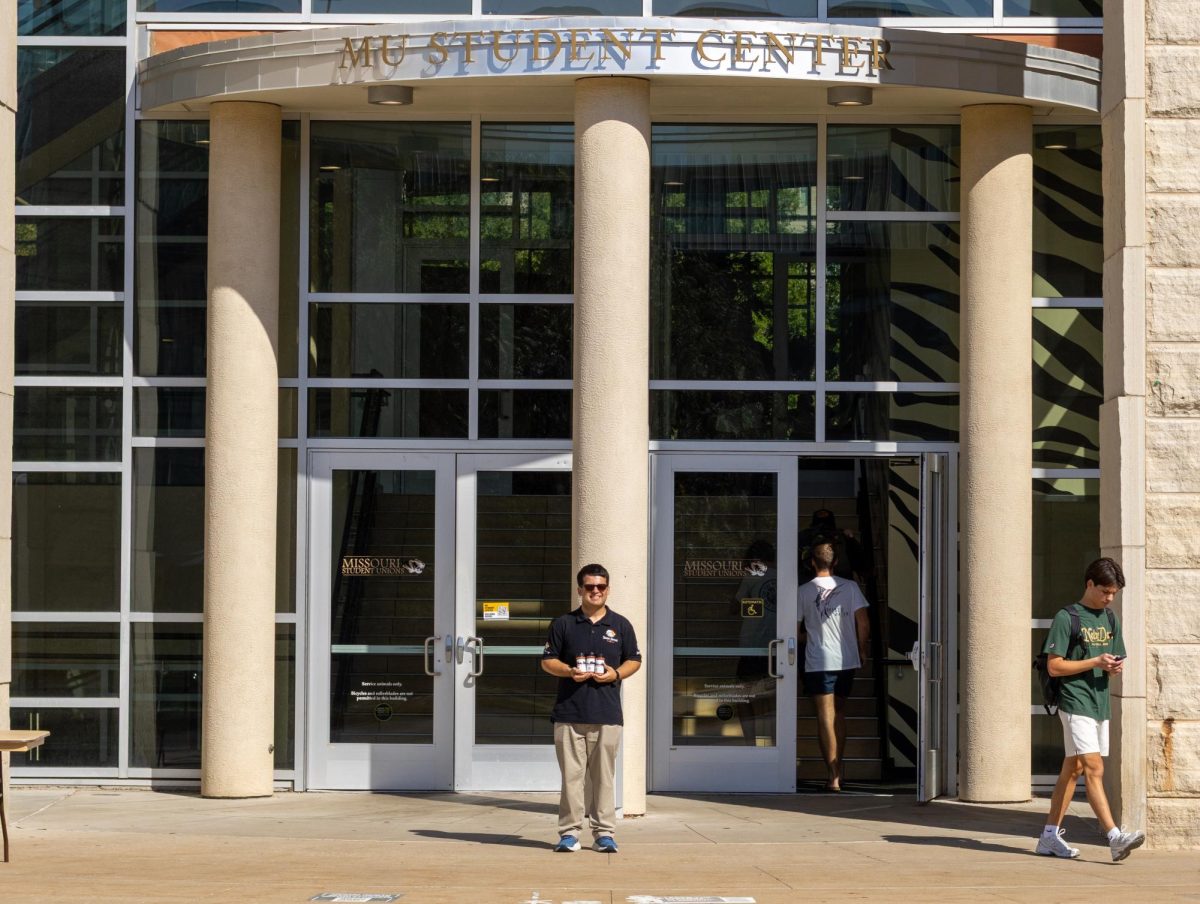When Dudley McCarter was working on his juris doctor at the MU School of Law from 1972 to 1975, the nation was beginning to crawl out of a costly war in Vietnam. As thousands of veterans returned home, many of them decided to return to school.
MU was no exception to what McCarter called a [sharp uptick in college enrollment](http://www.nytimes.com/1984/09/02/us/college-enrollment-linked-to-vietnam-war.html). He remembers the classrooms in Tate Hall at the time as “tight quarters,” and coursework as “rigorous and challenging.” He said that though the school did not intentionally try to weed students out of its program, the dean of the school once told students, “Some of you may not make it through the semester — because we have more of you here than we have room for.”
McCarter is now a principal attorney at the St. Louis-based law firm Behr, McCarter & Potter and the volunteer president of the Mizzou Alumni Association. He and hundreds of other alumni rallied for more state support for higher education during the 41st Legislative Day on Wednesday in Jefferson City.
McCarter is a father to three daughters, including Kat McCarter, who graduated from MU in 2011 with a degree in finance and real estate. He said tuition and fees at MU were much more attractive for prospective students 40 years ago than when his daughter attended the university. He is concerned that while tuition and enrollment at MU have climbed for decades, state support for universities has not kept up. This jeopardizes the balance, he said, between affordability and quality of education at MU.
“We have been in the [bottom five states for per capita funding for higher education](https://uminfopoint.umsystem.edu/media/fa/budget/operating/statefunding.pdf) for the last 15 years,” McCarter said. “Enrollment has gone up almost three times as much as our funding. We are educating more students at the UM System with less and less funding each year. But our cost of educating (students) has continued to go up and we’ve had to cut the fat, the muscle and now we are cutting into bone just to provide education.”
Between 1994 and 2014, MU’s tuition climbed from $158.76 to $274 per credit hour in 2013 dollars. [according to a report](https://www.themaneater.com/stories/2015/1/21/spain-johanson-report-targets-missouri-tuition/) compiled by MU junior Gunnar Johanson and MU’s Vice Provost for Undergraduate Studies Jim Spain.
The increasing cost of higher education is also reflected in national data: The average published tuition cost for in-state students at public four-year institutions skyrocketed about 225 percent between the 1984-85 and 2014-15 school years, [according to a College Board report](http://trends.collegeboard.org/college-pricing/figures-tables/average-rates-growth-published-charges-decade).
Chancellor R. Bowen Loftin said in a phone interview MU has actually managed to keep its rate of tuition increase below that of the rest of the nation, and he hopes to keep costs where they are now or at a lower rate. However, he said, greater state support is necessary for universities to maintain both affordability and quality of education.
“If we have less state support and we cannot raise tuition, then what has to suffer? The quality of education,” Loftin said. “I believe we have kept the quality of education very high at MU, but there are limits to how far we can go without state support.”
####Rallying cry
Loftin said between 400 and 500 alumni, faculty and staff of the UM System Wednesday and advocated for three legislative goals: A five percent increase in the system’s performance-based funding from last year; additional funds to complete major renovations and repairs on campus; and a continued support for the “50-50” fund match program.
Grants from the state are an essential source of relief for campus structures like Lafferre Hall, Loftin said. [Lafferre Hall received $38.5 million in state money in October 2014](https://www.themaneater.com/stories/2014/10/22/lafferre-renovation-start-early-2015/), after a report concluded that [91 percent of the building requires repairs or update](https://www.themaneater.com/stories/2014/2/25/inspection-mu-facilities-extends-beyond-campus/).
Other MU buildings like [McKee Gymnasium, Waters and Mumford halls are still in need](https://www.themaneater.com/stories/2014/10/29/mckee-waters-mumford-renovations-remain-unfunded/) of a rescue.
“We are hopeful that more funding will come down the pipe to repair high-priority buildings,” Loftin said. “They are good buildings that are structurally sound, but they need to be made better for students using them day in and day out for classes and laboratories.”
The 50-50 program, which was created with the passage of [Missouri Senate Bill 655](http://www.senate.mo.gov/12info/BTS_Web/Bill.aspx?SessionType=R&BillID=134153) in 2012, set aside money the state can use to match private donations raised by Missouri universities for new construction projects.
Loftin said MU has raised about $22 million in private money, [but the matching state funds were withheld](https://www.themaneater.com/stories/2014/1/22/state-state-nixon-budget-back-education-health-car/) by Gov. Jay Nixon until 2014.
“We’re trying to urge (legislators) to continue funding this process and work with the governor to find ways to get this done in the future,” he said. “Our donors really want to leverage their funds, and they are concerned they haven’t seen the state upholding its bargain by matching funding.”
Educators and former students made their way up and down halls of the capitol building throughout the day, stopping legislators and staffers to discuss their hopes for Missouri colleges and universities.
The debate over higher education funding is a complex issue, McCarter said, especially because of [increased tax cuts in Missouri](http://www.stltoday.com/news/local/govt-and-politics/missouri-legislature-overrides-nixon-s-tax-cut-veto/article_b4e9cc7f-8283-5dd6-ac9d-bb7b2abb0f06.html). McCarter said these cuts led to a decrease in the state’s revenue stream, shifting legislators’ focus from discretionary budget items like universities to things like state pension and salaries.
Despite some arguments that tax cuts could stimulate Missouri businesses, McCarter said he believes slashing sources of funding for education could do more harm than good.
“(Funding) is the key to attracting top students, top faculty members and more businesses to Missouri,” he said. “The business people I have talked to have told me they need to look outside the state of Missouri to get good employees who are knowledgeable have good backgrounds, mostly in the STEM area. Funding is the key; everything else falls into place when you have adequate funding.”
####Full house
Loftin said around midday, everyone gathered in the capitol rotunda for a speech from university officials such as Hank Foley, UM System vice president and senior vice chancellor at MU.
UM System President Tim Wolfe said on Twitter [he could not attend the rally due to commitments elsewhere](https://twitter.com/UMPrez/status/570682591063506946). He was unavailable for comment.
[An award ceremony](http://www.umsystem.edu/ums/news/media_archives/022515_news) took place, honoring “distinguished alumni,” such as Ron Wood, a graduate of the MU College of Engineering.
“It’s nice to have people who don’t have to be there — our alums who love Mizzou — talk from their heart about how important this university is to them,” Loftin said.
MU alum Lesa McCartney, currently vice president of performance improvement at Preferred Family Healthcare and chairwoman of Mizzou Legislative Network Committee, said the rally helped amplify voices supporting higher education.
“Our interest is to continue to grow the number of advocates and representatives for the University of Missouri,” she said. “The rotunda was full, and it was a nice representation of all the schools in the UM System … but we’d like to see more.”
Loftin said he was pleased by the turnout of the rally and is optimistic about the impact of the advocates. While greater state investment in higher education remains challenged by various interests and departments competing for a piece of the state budget, Loftin said universities remain an essential determinant of Missouri’s economic and intellectual future.
“We remind (legislators) all the time the university is the heartbeat of the state,” he said. “Our graduates fill jobs in the state, our faculty and researchers discover new knowledge every day and we serve over 2 million Missourians, which is about one-third of the (state) population, in a very direct way … Unless our education remains strong and have high quality, we won’t be able to fulfill the workforce demands or the academic vitality of the state.”













